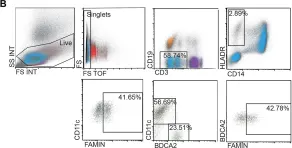Hepatocellular carcinoma (HCC) resists immunotherapy due to its immunosuppressive microenvironment. Sarcoma homology 2 domain-containing protein tyrosine phosphatase-1 (SHP-1) inhibits T cell receptor signaling, and its pharmacological inhibition is limited by poor selectivity and membrane permeability. Here, we generated CRISPR-edited SHP-1-knockout (KO) CD8+ T cells to enhance adoptive therapy against HCC. Single-cell RNA sequencing of HCC patient T cells revealed elevated SHP-1 in exhausted subsets. SHP-1-KO T cells exhibited increased effector memory T cells (TEM) proportions and enhanced IFN-γ/Granzyme B/perforin secretion, improving cytotoxicity against HCC lines. In humanized PDX models, SHP-1-KO T cells demonstrated superior tumor-killing activity. Transcriptomics identified upregulated lipid metabolism pathways, with HMGCR as a hub gene. Combining SHP-1-KO T cells with simvastatin (HMGCR inhibitor) synergistically amplified anti-HCC efficacy. This study proposes a dual strategy combining SHP-1-targeted cell therapy and metabolic modulation to overcome immunotherapy resistance, offering a translatable approach for HCC treatment.
© 2025 The Author(s).
Product Citations: 38
In IScience on 18 April 2025 by Liu, H., Ge, W., et al.
-
Cancer Research
In Biochemistry and Biophysics Reports on 1 September 2024 by Deng, X., Zhang, S., et al.
Mesenchymal stem cells (MSCs) have tremendous potential in cell therapy and regenerative medicine. The placenta-derived MSCs (PMSCs) are becoming favorable sources as they are ethically preferable and rich in MSCs. Although several subgroups of PMSCs have been identified from human term placenta, optimal sources for specific clinical applications remain to be elucidated. This study aimed to isolate MSCs from various components of the placenta, and compare their biological characteristics, including morphology, proliferation, immunophenotype, differentiation potential, growth factor and cytokine secretion, and immunomodulatory properties. Finally, four distinct groups of PMSCs were isolated from the placenta: amniotic membrane-derived MSCs (AM-MSCs), chorionic membrane-derived MSCs (CM-MSCs), chorionic plate-derived MSCs (CP-MSCs), and chorionic villi-derived MSCs (CV-MSCs). The results showed that CV-MSCs had good proliferation ability, and were easier to induce osteogenic and chondrogenic differentiation; CP-MSCs exhibited the strongest inhibitory effect on the proliferation of activated T cells, secreted high levels of EGF and IL-6, and could well differentiate into osteoblasts, adipocytes, and chondroblasts; AM-MSCs showed good growth dynamics in the early generations, were able to grow at high density, and tended to induce differentiation into osteogenic and neural lineages. These findings may provide novel evidence for the selection of seed cells in clinical application.
© 2024 Published by Elsevier B.V.
-
Stem Cells and Developmental Biology
In Cell Reports Medicine on 20 August 2024 by Grisendi, G., Dall'Ora, M., et al.
Pancreatic ductal adenocarcinoma (PDAC) still has a poor response to therapies, partly due to their cancer-associated fibroblasts (CAFs). Here, we investigate the synergistic impact of a combinatory approach between a known chemotherapy agent, such as gemcitabine (GEM), and gene-modified human mesenchymal stromal/stem cells (MSCs) secreting the pro-apoptotic soluble (s)TRAIL (sTRAIL MSCs) on both PDAC cells and CAFs. The combo significantly impacts on PDAC survival in 2D and 3D models. In orthotopic xenograft models, GEM and sTRAIL MSCs induce tumor architecture shredding with a reduction of CK7- and CK8/18-positive cancer cells and the abrogation of spleen metastases. A cytotoxic effect on primary human CAFs is also observed along with an alteration of their transcriptome and a reduction of the related desmoplasia. Collectively, we demonstrate a promising therapeutic profile of combining GEM and sTRAIL MSCs to target both tumoral and stromal compartments in PDAC.
Copyright © 2024 The Authors. Published by Elsevier Inc. All rights reserved.
-
Cancer Research
In Pharmaceutics on 7 September 2023 by Liu, H., He, R., et al.
Lung cancer, as one of the high-mortality cancers, seriously affects the normal life of people. Non-small cell lung cancer (NSCLC) accounts for a high proportion of the overall incidence of lung cancer, and identifying therapeutic targets of NSCLC is of vital significance. This study attempted to elucidate the regulatory mechanism of transcription factor 21 (TCF21) on the immunosuppressive effect of tumor-associated macrophages (TAM) in NSCLC. The experimental results revealed that the expression of TCF21 was decreased in lung cancer cells and TAM. Macrophage polarization affected T cell viability and tumor-killing greatly, and M2-type polarization reduced the viability and tumor-killing of CD8+T cells. Meanwhile, overexpression of TCF21 promoted the polarization of TAM to M1 macrophages and the enhancement of macrophages to the viability of T cells. Furthermore, there appears to be a targeting relationship between TCF21 and Notch, suggesting that TCF21 exerts its influence via the Notch signaling pathway. This study demonstrated the polarization regulation of TAM to regulate the immunosuppressive effect, which provides novel targets for the treatment of lung cancer.
-
FC/FACS
-
Cancer Research
In Nature Communications on 20 July 2023 by Gao, Y., Chi, Y., et al.
Mesenchymal stem cells (MSCs) possess potent immunomodulatory activity and have been extensively investigated for their therapeutic potential in treating inflammatory disorders. However, the mechanisms underlying the immunosuppressive function of MSCs are not fully understood, hindering the development of standardized MSC-based therapies for clinical use. In this study, we profile the single-cell transcriptomes of MSCs isolated from adipose tissue (AD), bone marrow (BM), placental chorionic membrane (PM), and umbilical cord (UC). Our results demonstrate that MSCs undergo a progressive aging process and that the cellular senescence state influences their immunosuppressive activity by downregulating PD-L1 expression. Through integrated analysis of single-cell transcriptomic and proteomic data, we identify GATA2 as a regulator of MSC senescence and PD-L1 expression. Overall, our findings highlight the roles of cell aging and PD-L1 expression in modulating the immunosuppressive efficacy of MSCs and implicating perinatal MSC therapy for clinical applications in inflammatory disorders.
© 2023. The Author(s).
-
FC/FACS
-
Stem Cells and Developmental Biology
In PLoS One on 14 December 2016 by Assadi, G., Vesterlund, L., et al.
Fig.4.B

-
FC/FACS
-
Homo sapiens (Human)
Collected and cropped from PLoS One by CiteAb, provided under a CC-BY license
Image 1 of 1
